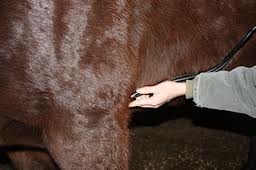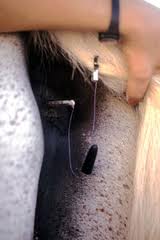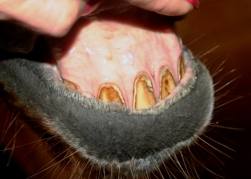|
Equine vital signs consist of temperature, pulse, and respiration ( TPR)Equine Vital Signs Temperature, pulse, and respiration (TPR) are the basic physiological parameters every horse owner or care provider should know if he or she wants to take proper care of a horse. These three measurements are very important and can greatly help you and your veterinarian when you think your horse might be sick. Just knowing the normal values for these three equine vital signs can provide great insight about your horse's physiological state.

Normal TPR To know if your horse's TPR values are abnormal, you first need to know what is normal. Although the normal heart rate for most horses is 32 to 36 beats per minute, some horses have lower heart rates, 24 beats per minute, or maybe slightly higher heart rates, 40 beats per minute.
To check equine vital signs you will need a thermometer, a stethoscope, and a watch with a second hand or one that counts seconds. A digital thermometer should be used because the time required for a reading is much less and it is more flexible than a glass mercury thermometer. The thermometer should have a small hole at the end so a long piece of brightly colored string or tape can be attached to help find the thermometer if it is dropped or lost in the stall.
A small clamp or clothespin can be placed at the end of the string so it can be attached to the horse's tail and left in place until the temperature can be read. In that way, you do not have to hold the thermometer in place. For equine vital signs, you can purchase these thermometers at any drug store. The stethoscope is used to clearly hear the heart beating and the sounds of breathing. An inexpensive stethoscope can be purchased at a drug or horse supply store that will be sufficient to hear the heartbeat and determine a heart rate (pulse) and respiratory rate.

Temperature Rectal temperature is easily taken for equine vital signs on most horses by placing a small amount of lubricant (petroleum jelly) on the thermometer. Approach the horse from the side; do not stand directly behind the horse in case they decide to kick. Raise or move the horse's tail and insert the thermometer into the anus. Thermometers designed for use with livestock have a ring on the top. This ring can be attached to a string and a clip attached to the opposite end of the string. The clip can be clipped to the horse's tail when you take the horse's temperature.
The normal rectal temperature of a horse is 99.5 to 101.5°F (37.5 to 38.6ºC). Foals less than 1 month of age have a normal temperature of 100.0 to 102.0°F (37.7 to 38.8ºC). Newborn foals can easily suffer from hypothermia (low body temperature), so if the foal's temperature is below 98.0°F (36.6ºC), call your veterinarian. In the meantime, rub the foal with towels or blankets to stimulate blood flow and/or dry its coat. If the horse's rectal temperature is above normal, it has a fever, not a temperature. All horses have a temperature, either above normal (fever), below normal (hypothermia), or normal.
Pulse The heart rate can be taken without a stethoscope, but having a stethoscope makes the job easier. If a stethoscope is not handy, the pulse can be taken from the facial artery, which is on the bottom side of the jaw in a shallow groove beneath the last cheek tooth. Count the number of beats for 15 seconds, then multiply by four to calculate the heart rate in beats per minute. Remember, any excitement by the horse will increase the pulse rate.
If a stethoscope is available, listen to the heart on the left side of the horse's chest, just behind the elbow. Each sound of the heart is considered one beat. The normal heart rate for an adult horse is about 32 to 36 beats per minute. Foal heart rates vary depending on age. Newborn foals have a heart rate of between 80 to 100 beats per minute. Foals which are a few weeks to a few months of age will have heart rates of 60 to 80 beats per minute.
Respiration With equine vital signs, respiration can be taken by watching the horse's chest move in and out (an inhale and exhale is one breath) or feeling the air come out of the nostrils. The stethoscope can be used to listen to the breaths as the air travels across the trachea when the horse inhales and exhales. Respiration characteristics should also be noted. Is the sound clear? Are the breaths shallow or deep? Is there any abnormal squeaking or crackling sound associated with the breathing?
The normal respiratory rate for adult horses is eight to 12 breaths per minute. Newborn foals have respiratory rates that are 60 to 80 breaths per minute. Older foals have resting respiratory rates from 20 to 40 breaths per minute. Remember, if your horse or foal becomes excited for any reason, the respiratory rate can be temporarily elevated.

Capillary Refill Time Another indicator of health is mucous membrane, or gum, color. Healthy horses have nice pink gums that are moist to the touch. Capillary refill time is tested by pressing your finger firmly on the gum above the front incisors and removing it quickly. The time it takes for the area to turn from white back to pink is the capillary refill time. Normal refill time is about 2 seconds. If capillary refill time is longer than 2 seconds you should note the color of the mucous membrane and contact your veterinarian.
You greatly increase your horse's chance of surviving a serious illness or accident by knowing the basic equine vital signs and being able to take the vital signs in an emergency.
SOURCE - C. Wood, Equine vital signs
Return from Equine Vital Signs to Horse Riding Connection
|
